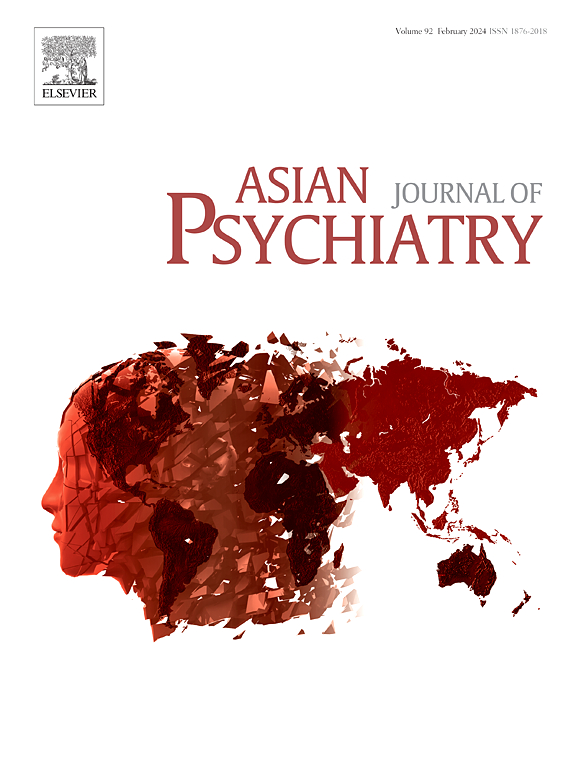土耳其精神疾病法医精神病患者住院攻击风险因素及新预测模型的前瞻性研究
IF 3.8
4区 医学
Q1 PSYCHIATRY
引用次数: 0
摘要
精神科住院病人的攻击行为会造成伤害并扰乱护理。虽然它们经常与可改变的风险因素联系在一起,但它们的作用尚不清楚,许多预测工具都忽略了它们。本研究旨在评估土耳其法医学精神病患者的危险因素与住院患者攻击行为之间的关系,并建立人群特异性预测模型。方法对8个静态危险因素和10个动态危险因素进行评价。动态因素每两周收集一次,结果定义为评估轮之间的任何身体或言语攻击。多水平逻辑回归分析评估了动态危险因素与结果之间的关系。一个新的特定人群的预测模型是通过修改以前在别处开发的(FOxWeb)。采用包含固定效应的模型来评估预测性能。结果在4个月内,102例法医精神科住院患者共进行了811次动态风险评估,记录了603起攻击事件。至少有42名患者卷入了一起事件。在单变量和多变量分析中,许多动态因素与结果显著相关。总动态评分是一个显著的预测因子,与单独使用静态因素的模型(AUC=0.73, 95 % CI: 0.69-0.77)相比,固定效应模型(AUC= 0.84, 95 % CI: 0.81-0.87)的辨别能力得到了提高。结论动态因子与静态因子相结合的预测模型具有较好的攻击风险评估效果。将现有的预测模型修改为特定的人群可能会提供更好的性能,但这需要在独立样本中进行外部验证,因为开发模型可能会过拟合。高质量的预测模型可以加强干预,优化资源利用,改善临床决策。本文章由计算机程序翻译,如有差异,请以英文原文为准。
A prospective study of risk factors and new prediction model for inpatient aggression in a Turkish forensic psychiatric cohort with psychotic illness
Background
Aggression among psychiatric inpatients causes harm and disrupts care. While often linked to modifiable risk factors, their role remains unclear, and many prediction tools overlook them. This study aimed to assess the relationship between risk factors and inpatient aggression among forensic patients with psychotic disorders in Turkiye and to develop a population-specific prediction model.
Methods
Eight static and ten dynamic risk factors were assessed. Dynamic factors were collected fortnightly, with the outcome defined as any physical or verbal aggression between assessment rounds. Multilevel logistic regression analyses assessed the association between dynamic risk factors and outcomes. A new population-specific prediction model was developed by refitting the previously developed elsewhere (FOxWeb). Models incorporating fixed effects were used to assess predictive performance.
Results
Over four months, 102 forensic psychiatric inpatients underwent 811 dynamic risk assessments, with 603 aggressive incidents recorded. Forty-two patients were involved in at least one incident. Many dynamic factors were significantly associated with outcomes in both univariable and multivariable analyses. The total dynamic score was a significant predictor, improving the discrimination of the fixed-effects model (AUC = 0.84, 95 % CI: 0.81–0.87) compared to the model using static factors alone (AUC=0.73, 95 % CI: 0.69–0.77).
Conclusion
Combining dynamic and static factors in the prediction model showed strong performance for assessing aggression risk. Refitting existing prediction models to specific populations may offer enhanced performance, but this requires external validation in independent samples as development models may be overfitted. Highly quality predicative models could enhance interventions, optimize resource use, and improve clinical decision-making.
求助全文
通过发布文献求助,成功后即可免费获取论文全文。
去求助
来源期刊

Asian journal of psychiatry
Medicine-Psychiatry and Mental Health
CiteScore
12.70
自引率
5.30%
发文量
297
审稿时长
35 days
期刊介绍:
The Asian Journal of Psychiatry serves as a comprehensive resource for psychiatrists, mental health clinicians, neurologists, physicians, mental health students, and policymakers. Its goal is to facilitate the exchange of research findings and clinical practices between Asia and the global community. The journal focuses on psychiatric research relevant to Asia, covering preclinical, clinical, service system, and policy development topics. It also highlights the socio-cultural diversity of the region in relation to mental health.
 求助内容:
求助内容: 应助结果提醒方式:
应助结果提醒方式:


